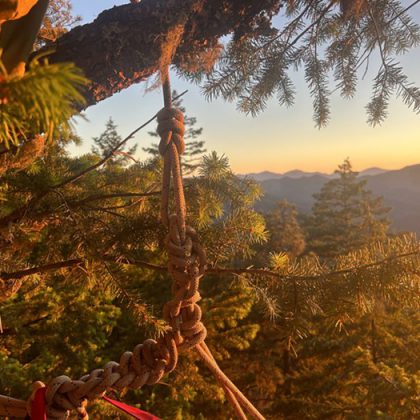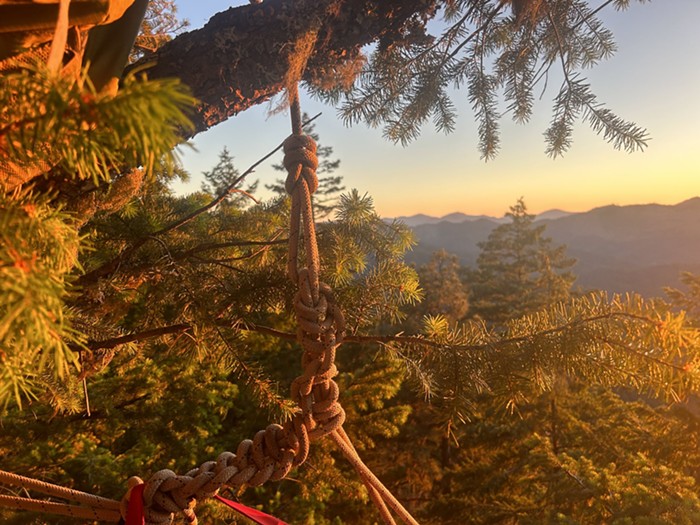Feature your business, services, products, events & news. Submit Website.
Breaking Top Featured Content:
Activists Reignite the Battle for Oregon’s Old-Growth Timber

by Taylor Griggs
It’s a big year for forest conservationists in Oregon, who are using a variety of tactics— deploying different levels of civil disobedience—to fight against continued old growth logging around the state.
Old growth forest advocates say the trees–which define the Pacific Northwest’s iconic landscape–are not only beautiful, they’re necessary for mitigating the worsening impacts of the climate crisis. And despite plans to preserve them, these old growth forests are at risk.
At a rally last week outside the Forest Service’s Pacific Northwest regional headquarters in downtown Portland, environmental activists called attention to the United States Forest Service’s objective to amend the plan that dictates management of federal forest land in the Pacific Northwest. Activists say the current plan, while instrumental in protecting the region’s oldest trees during a time of mass deforestation, has loopholes allowing the U.S. Forest Service and Bureau of Land Management (BLM) to carry out commercial logging projects in old growth forests.
The Forest Service, in accordance with a 2022 executive order from President Biden, has proposed the National Old-Growth Amendment: The “first-of-its kind proposal to amend all 128 forest land management plans” across the country. According to the Forest Service, the proposed amendment is “intended to provide consistent direction to conserve and steward old-growth forest conditions in response to rapidly changing climate conditions.”
At last week’s rally, activists urged people to participate in the upcoming public engagement period for the amended plan, which will impact the region’s forests for decades to come.
Meanwhile, in other parts of the state, activists have staged tree-sits, taking up temporary residence in 100-foot Douglas firs on Bureau of Land Management (BLM) land to protest commercial logging and forest management policies.
Activists say both strategies are necessary to protect Oregon’s ancient forests.
The Northwest Forest Plan
In 1994, after years of environmental protests over the degradation of the Pacific Northwest’s old growth forests, the United States Forest Service adopted a landmark ecosystem protection plan. Thirty years later, the plan is set to be amended, and environmental activists see another major opportunity to preserve what’s left of the Pacific Northwest’s ancient forests.
Since the first iteration of the Northwest Forest Plan (NWFP) was adopted by President Bill Clinton, there’s been a paradigm shift in the environmental movement. The rallying cry during the 1980s and ‘90s timber protests was to save endangered species, notably the iconic Northern spotted owl, by protecting their forest ecosystems. While activists are still focused on preserving endangered species habitat, they’re also much more aware of the threats of climate change and the role of forests— especially old growth forests— in mitigating those threats.
With the growing threat of the climate crisis in mind, President Biden issued a 2022 executive order to “take action to conserve, restore, reforest, and manage our magnificent forests.” At the end of last year, the U.S. Department of Agriculture (USDA) announced a proposal to carry out the goals of that executive order with the National Old-Growth Amendment, which will revise forest land management plans to “conserve and steward old-growth forest conditions on national forests and grasslands nationwide.”
“This really is an extraordinary time for our national forests,” Angela Sondenaa, a certified senior ecologist and member of the NWFP federal advisory committee, said at last week’s rally. “[This is] your opportunity to have a voice, and help shape plans that will govern our national forest management for decades to come.”
Sondenaa, who is a Siletz tribal member, also discussed the value trees hold in Native American communities across the region, and the importance of including tribal perspectives in the plan amendment process.
“In the original Northwest Forest Plan efforts, tribes were not included at all…[tribal] worldviews were not deemed valuable enough for the administration to consult us. In this go-around, that’s different,” she said. “These forests are sacred to indigenous people. There’s no way to separate indigenous cultures from the environment and the landscapes where they evolved.”
Brenna Bell, the forest climate manager at environmental justice group 350 PDX, pointed out at the rally that “timber production is still the primary value for most forest management in the Northwest.”
“Even the areas that have some degree of protection have loopholes,” Bell said. “There’s logging in late-successional reserves and in riparian reserves, often under the guise of fire prevention or forest health.”
“In the original Northwest Forest Plan efforts, tribes were not included at all…[tribal] worldviews were not deemed valuable enough for the administration to consult us. In this go-around, that’s different. These forests are sacred to indigenous people. There’s no way to separate indigenous cultures from the environment and the landscapes where they evolved.” -Angela Sondenaa
While forest management agencies have long maintained logging is necessary for forest fire prevention, tree conservationists disagree— and science backs them up. The timber industry, which remains widely influential across the region, has a vested interest in promoting logging as an environmentally sustainable decision. However, studies have shown that logging is not effective at reducing forest fires, and old growth forests are, in fact, often more resilient to fire.
In a letter to the Biden administration and the Forest Service, signed by 70 environmental organizations from across the country, activists urged leaders to close the logging loopholes. The letter calls on Biden to issue a new executive order “establishing an immediate moratorium on logging old growth forests until such a time as permanent and legally binding protections for these forests are in place.”
“Brave leadership is needed to enact a paradigm shift for federal forest management that prioritizes biodiversity, clean cold water, carbon storage, connectivity and core habitats for wildlife, and unfragmented forests,” the letter says. “It is long past time to move away from outdated strategies of large scale resource extraction on federal public lands. Such changes are needed to avert the worst of the climate crisis, as well as for ensuring clean drinking water and livable communities.”
The letter also asks the Biden administration to ensure the Forest Service and BLM recognize logging as a threat to old growth forests and reduce or eliminate their annual timber harvest quotas, which activists say leads to excessive and unnecessary logging.
Tree sitters take direct action

The view from the treetops at the Rogue Gold Forest Management tree-sit.
pacific northwest forest defense
Activists say you don’t have to look very far to see examples of the Forest Service and BLM taking advantage of the NWFP’s loopholes. And as some environmentalists pen letters to the president, others have staked a place in the trees.
Earlier this month, protesters began a tree-sit action at the BLM’s Rogue Gold Forest Management Project in southern Oregon, with activists perched in old growth trees hundreds of feet in the air. The protesters say mature and old growth trees in the Rogue Gold area are “threatened by the BLM’s practice of utilizing roadbuilding loopholes to aggressively log threatened ecosystems across Oregon.”
This is the second tree-sit in southern Oregon in the last several months. Protesters occupied the BLM’s Poor Windy Timber Sale in April, and claimed victory after the agency agreed to preserve a section of old-growth forest from an approved logging project.
“BLM logging projects like Poor Windy and Rogue Gold are targeting some of the last remaining stands of old, carbon-rich trees that are left in Oregon,” protest organizer Sam Shields said in a press release. “Cutting down trees does not make forests more resilient to fire, as the BLM wants us to believe, but actually has the opposite effect – increasing wildfire risk, endangering our communities and driving the climate crisis.”
In an interview with Oregon Public Broadcasting, Shields said “it’s more clear than ever that taking direct action…is an effective strategy for protecting these forests,” and called this period a “renaissance” for tree-sitting. The tactic was popularized during the timber protests of 30 years ago, with tree-sitting pioneers staking out spots in the Willamette National Forest to protect Northern spotted owl ecosystems.
Back in Portland, forest advocates say it’s okay if you’re afraid of heights— there are other ways to make a difference.
“I really implore you to use your voice. Use your power as citizens of a free and open democracy to get engaged in these public processes, and tell your elected officials, your public servants, how you want your forests and your national lands managed,” Sondenaa said at last week’s rally. “Because it matters. It matters to the wildlife, the waters, the air, all of us.”
Bell echoed Sondenaa’s words, urging people to keep up their activism even if it feels inconsequential in the face of the climate crisis.
“Sometimes the scale of changes that we’re facing make any action we take too little and too late. But to each tree that’s still standing in the forest, our action can make a difference,” Bell said. “For those trees, our actions are not too little too late. Protecting the old growth isn’t going to change everything. But for the lives of those trees, it will change everything.”
Continue Reading at PortlandMercury.com here
